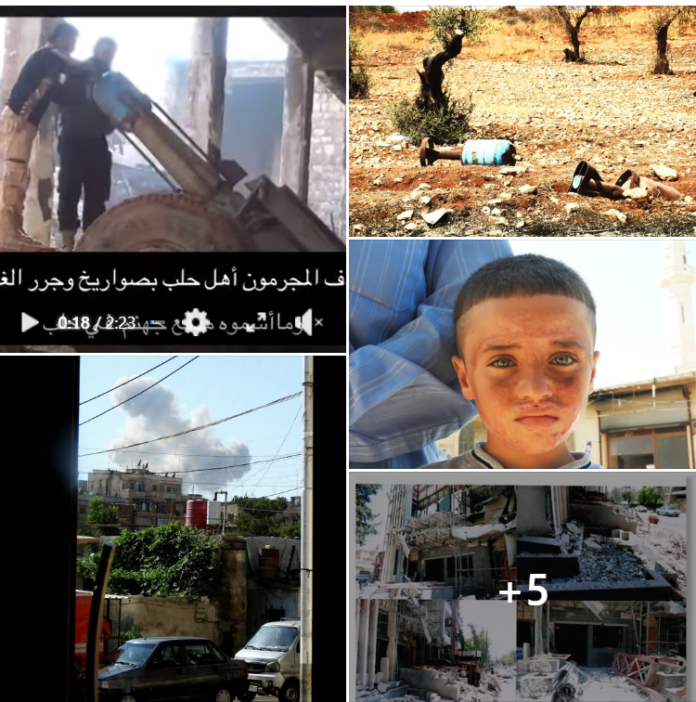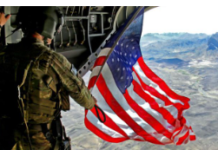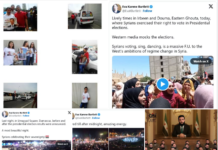“Barrel bombs…
I challenge anyone to say that the Mufti issued a fatwa regarding barrel bombs. In response to these liars, this is what His Eminence the Mufti called for when Aleppo was bombarded with the Hell Cannon, targeting mosques, homes, children, and women. (We and any rational person are against barrel bombs, against the Hell Cannon, and against the killing of innocents, regardless of their religion, sect, or ethnicity.)
His Eminence’s words were that civilians must evacuate, and he urged, not issued a fatwa (and this is a big difference). He did not mention barrel bombs or anything similar.
**
Mufti Hassoun was indeed telling the truth about the incessant mortaring & hell canon shelling ( & sniping) of the terrorists onto civilian areas of Aleppo (and Damascus, and elsewhere…).
His words were constantly distorted, mistranslated or flat out lied about by Western, Gulf & Zionist media. He is a man of peace and generosity, love and forgiveness. HE SHOULD NOT BE IMPRISONED OR TORTURED.
By the end of 2016, nearly 11,000 civilians had been killed by terrorists in Aleppo–civilians, not Syrian military.
Some excerpts from my writings in 2016, when I went 4 times to Aleppo:
“One of the older charities in Aleppo is The Association of Raising the Standard of Health and Social Status, established in 1964. In the 1970s, Syria’s Grand Mufti, Dr. Ahmad Badr Al-Din Hassoun, became the director of the association. Even during the current situation, it every month provides 3,000 families with aid, including medicine, food aid, and when needed, school clothes and supplies.
The storage room of Mufti Hassoun’s mosque in Aleppo is crammed full of the association’s aid items, also including mattresses, blankets, and diapers and baby-related items to be given to those in need.
In Damascus, Mufti Hassoun explained further about the association’s charitable work, and the attacks by terrorist factions in Aleppo.
“We have two hospitals and ten medical clinics in Aleppo. Every day, they received between 1,000-1,500 patients. Treatment and medicines are free.
Terrorists invaded the first hospital, the Omar Ibn Abdul Aziz hospital, in the Maadi district. It used to have three operating rooms, an MRI, and fifty beds. The terrorists stole most of this.
It also had three ambulances, gifts from Europe, which operated as mobile clinics. We used to send them to villages around Aleppo with both a female and male doctor, for those who couldn’t get into Aleppo.
The terrorists stole the ambulances and mounted machine guns on them.
The second hospital, in Ashrafiya, has thirteen floors and 250 rooms. The hospital as a building is finished, and the first and second floors are operational as medical clinics. However, it is near Beni Zeid area, where terrorists are, including many snipers. We stopped further work on and the hospital because of the sniping. Some nurses and doctors were killed by the sniping.”
These are some of the medical and charitable initiatives in Aleppo which will never make the headlines, as they defy the corporate lies on sectarianism in Syria and a lack of doctors in Aleppo.”
*
Ramadan prayers in the Rowda mosque, where Grand Mufti Hassoun used to give sermons. According to his assistant, before the war on Syria about 500 women regularly came to pray at the mosque.
“Six or so months ago, a mortar hit the mosque. It bounced off the dome and fell outside in the courtyard. There were about 400 children here learning the Quran. If it had gone through the roof, it would have killed a lot of children,” he said.
The worshippers at this mosque are predominately Sunni, in a city secured by the Syrian government. This is notable in that it contradicts the Western media’s blatant propaganda about a sectarian war, a “Sunni uprising against the government”.
From Aziziya district, on July 4, half a kilometer away, the explosion of a terrorist-fired bomb. Around 5 pm, this is a busy time when streets are packed with cars and pedestrians; terrorists know they can kill and maim more civilians when attacking at these busy hours. Minutes later, an anti-aircraft explosive bullet landed roughly 15 metres away from my Aziziya venue. Had it landed on one of the parked cars, there would have been many casualties. A day later, such an explosive bullet killed the mother of an Aleppo friend, at her home.
*
Hell Cannon-fired gas canister bombs litter the countryside around Aleppo and on the route to Nubl and Zahra’a. These, and larger variations, are what Western-backed terrorists have rained down on the city of Aleppo, as well as besieged Foua and Kafarya in Idlib governorate (see more on Foua and Kafarya). Manufactured locally, fired upon civilians daily, gas canister bombs get virtually no mention in corporate media, although their impact is deadly.
*
Abdul Karim Assad, 7, has painful face disfiguration from a terrorist-fired mortar which burned his face. Under siege at the time, the boy was only treated with basic medical care in a bare-bones hospital in Zahra’a. The boy is not originally from Nubl, but from Idlib, from which his grandfather fled when terrorists invaded. He is another poster child for the terrorism inflicted upon Syria.
*
When I met him in July 2016, Dr. Antaki continued to be vocal about the media manipulations and flagrant lies about the reality on the ground in Aleppo.
“All of the campaigns which were launched by the western media concerned the east part of Aleppo, which is the part controlled by the ‘rebels’. All the media reported that the people there are suffering, the buildings are destroyed and that the Syrian government are doing ‘war crimes’. But, what we are receiving in the part controlled by the Syrian government is much worse than in the east part. Nobody speaks about what is happening in the western part of Aleppo. There are not only tens of mortars every day which fell on the western part of Aleppo, but hundreds, and every day we have hundreds killed or wounded. And nobody spoke about it. When the media spoke about one supposed hospital destroyed in the eastern part, one week after, the main maternity hospital in Aleppo was hit by bombs sent by the ‘rebels’, and women were killed, and nobody spoke about this.”
Dr. Nabil Antaki gave the following overview of life for the civilians of government-secured Aleppo, from mid-2012 until our July meeting.
Since July 2012, the main area of Aleppo receives every day mortars, bombs and gas canisters, sent by the ‘rebels’ on the civilians living in Aleppo. Here you have human damage more than there, but less physical destruction, because here we are receiving mortars and gas canister bombs. If a mortar hits the building, it might make a hole the size of a window, but also kill five people at once. In the part of Aleppo under the government control, every day we have dozens of injured and killed.
In late April 2016, terrorists in the occupied eastern quarters of Aleppo, as well as then-occupied Bani Zeid and neighbouring districts, increased their normal bombing campaigns of mortars, gas canister explosives (from household to the the largest size canisters, stuffed with glass, bearings, metal shrapnel), explosive bullets, and powerful foreign-supplied rockets to from high-tens to over one hundred per day on the heavily-populated areas of Aleppo secured by the Syrian state.
Of the heightened bombardment, Dr. Nabil Antaki told me:
Usually you don’t have just one mortar, you have a rain of mortars: ten, twenty, thirty, and more in a few hours. Many people are wounded at the same time. When ambulances bring people to the public hospital, maybe twenty or thirty people arrive at the same time. The public hospitals lack enough medical staff and equipment. So if you have ten severely wounded persons arriving at the same time at the public hospital, by the time care comes, a victim has time to die.
In his Aleppo Medical Association office, Dr. Zaher Buttal read from his diary statistics on the late April/early May terrorists’ bombardment campaign:
April 23rd: 81 martyrs, 30 wounded.
April 28th & 29th: Bloodiest days. 31 martyrs, 75 wounded **initial numbers only.
From April 23rd-30th: 120 martyrs, over 800 wounded.
May 3rd: 25 martyrs, 100 wounded (including 3 women killed in the al-Dabeet maternity hospital explosion).
Although the Aleppo Medical Association documented the daily number of killed and injured by this increased bombing campaign, and although the areas attacked included a number of registered Aleppo hospitals, corporate media and Wall Street-backed “human rights groups” in their Turkish-based, or further-removed, reporting on Aleppo preferred to cite “unnamed activists” and al-Qaeda-in-Syria “White Helmets” actors….
…A Western-backed terrorist rocket explodes outside Dabeet Maternity hospital in Aleppo
While initial reports said 16 civilians were killed in the May 3rd terrorist bombings, by the time the wounded had succumbed to their severe injuries, 25 people were killed and over 100 injured, according to the medical association’s Dr. Zaher Buttal. The three women killed were in the al-Dabeet hospital reception at the time, said Dr. Dabeet. One of the injured included a 28-week-pregnant woman who survived the loss of long sections of her intestine due to shrapnel injuries.
The operating room was destroyed, along with patient rooms, five of ten incubators (the other five needing repair), and much of his equipment.
One week later the maternity hospital was again hit by a terrorist-fired mortar, destroying the roof and injuring construction workers there, according to Dr. Dabeet.
According to Dr. Zaher Buttal, other hospitals hit include the Ibn Rashd hospital, with a mortar hitting the top floor, the Arab Medicine hospital, and the perimeter of the Razi hospital.
*
Inside his church, a new structure built about a year ago to replace the historic church destroyed by terrorists in years prior, Rev. Nseir introduced three Sunni leaders from the city: Dr. Rami Obeid, Dr. Rabih Kukeh, Sheikh Ahmed Ghazeli.
“These Sunni leaders are considered ‘infidels’ by al-Nusra and company,” Nseir said, explaining that they don’t follow the distorted Wahhabi ideology guiding the Western-backed terrorist factions like the Nusra Front and others which had been deemed “moderate rebels” and “opposition forces.”
Before turning the floor over to these religious leaders, Rev. Nseir noted:
“When the church was destroyed, the first person to call me was Mufti Hassoun, who told me, ‘Don’t worry, reverend, we’ll rebuild the church.’”
*
On the afternoon of Nov. 3, after meeting with Dr. Mohammed Batikh, director of Al-Razi Hospital, the victims of terror attacks which had begun a few hours prior began to arrive one after another, maimed and critically injured. The vehicle bombings and bombardment of Grad missiles, among other attacks, left 18 people dead and more than 200 injured, according to Dr. Zaher Hajo, the head of forensic medicine at Al-Razi Hospital.
The corridors and emergency ward at Al-Razi Hospital, one of two state-run hospitals in Aleppo, quickly became clogged with the injured and grieving family members. In one crowded interior corridor, one of the wounded screamed out in pain: “Ya, Allah! Ya, Allah!”
In another corridor, a 15-year-old boy with a cast on one leg and bandages on his head, said the mortar attack which injured him had killed his 4-year-old cousin and left his 6-year-old cousin with critical injuries.
In a front room, a mother wailed for her son who had suffered severe injuries. She screamed and pleaded for someone to save him, her only son. Not long after, though, the news came in: the 26-year-old had died. Her son, a doctor, was not the first medical professional to die in terrorists’ routine bombings of Aleppo neighborhoods.
Dr. Nabil Antaki, a gastroenterologist from Aleppo, with whom I met on my trips to Aleppo in July and August, messaged me in October about his friend and colleague, Dr. Omar, who was injured on Oct. 6 when terrorist factions unleashed an attack on Jamiliye Street, killing 10 people. Just a few days after the attack, Dr. Omar, too, died.
At the morgue behind Al-Razi Hospital on Nov. 3, inconsolable family members leaned against the wall or sat on the pavement, coming to grips with the deaths of loved ones.
One 14-year-old boy had been there on Nov. 2, when his father was killed. On Nov. 3, he returned when his mother was killed. Both of this boy’s parents are dead, both killed in terrorist attacks on the city’s New Aleppo district.
A man spoke of a 10-year-old nephew who was shot in the head by a terrorist sniper while the boy was on his roof.
A woman and her children leaned against an iron rail next to the door to the morgue, weeping over the death of her husband, their father, who was killed while parking a car. When the man’s mother arrived, she collapsed, shrieking in grief.
And in the midst of all of this, all these women and children, a car arrived at the morgue with the body of yet another victim of the day’s terror attacks, Mohammed Majd Darwish, 74. His upper body was so bloody that it was unclear whether he had been decapitated.
Near the morgue, Bashir Shehadeh, a man in his forties, said his family had been displaced already from Jisr al-Shughour, a city in Idlib. His mother, some of his friends, and his cousin have been killed by terrorist factions’ shellings. He said enough was enough, and called on the SAA to eliminate the terrorist threat.
Al-Razi’s Dr. Batikh said a private hospital, Al-Rajaa, was hit by a mortar attack. “They cannot do operations now, the operating room is out of service.”
On Sept. 10, Dr. Antaki messaged me:
“Yesterday, a rocket, sent by the terrorists, hit a maternity hospital in Aleppo in Muhafazat Street. Two persons working in the hospital were injured. No death. But the point is that it is a hospital and it was hit by a rocket.”
Dr. Batikh and Dr. Mazen Rahmoun, deputy director of Al-Razi, said the hospital once had 68 ambulances, but now there are only six. The rest, they said, were either stolen by terrorist factions or destroyed.
Aleppo’s doctors continue to treat the daily influx of injured and ill patients in spite of the dearth of ambulances and effects of Western sanctions which mean a lack of medical equipment, replacement parts, and medicine for critical illnesses like cancer.
According to the hospital’s head forensic medicine, Dr. Hajo, in the last five years, 10,750 civilians have been killed in Aleppo, 40 percent of whom were women and children. In the past year alone, 328 children have been killed by terrorist shelling in Aleppo, and 45 children were killed by terrorist snipers…
At the Castello Road humanitarian crossing, the large green buses which were said to be evacuating militants from areas of eastern Aleppo in recent weeks were there again, waiting to ferry away more. Ten ambulances, three buses, and 14 minivans were lined up in anticipation of any civilians or militants trying to leave terrorist-occupied areas, whether for safe passage elsewhere or to settle in government-secured areas of Aleppo.
At around 1:30 p.m. the first shell struck, hitting near Castello Road. About 10 minutes later, while I was being interviewed, a second hit, this time considerably closer, within 100 meters — close enough, in fact, to create a cloud of dark smoke over the road. It prompted security to usher me away from the road and move our delegation away from the crossing.
I later learned that another five shells targeted the crossing, injuring a Syrian journalist and two Russian soldiers.
No one passed through this or any of the other seven humanitarian corridors that day.
…Displaced by terrorists
For around four years, simple shelters at the Hafez al-Assad Mosque have housed around 1,000 people, all Sunni families displaced from areas occupied by militants.
Most of those with whom I spoke listed similar reasons for leaving their homes and described being in fear for their lives because of the terrorist presence.
“They came and destroyed houses and killed civilians before they attacked the state. The army is protecting us, it’s the gangs [that] are the ones destroying the country,” one man told me.
He said his two brothers in terrorist-controlled areas in eastern Aleppo are “not allowed to leave.”
“They’ve tried many times but they are prevented. If the armed groups see anyone carrying luggage, they’ll arrest them right away.”
He and others at the shelter complained that, according to their family members, the terrorist factions horde and control any food within the areas they occupy.
Like elsewhere in the city, the shelter and area immediately surrounding the mosque are routinely hit with mortars and explosive bullets.
An older man led me around a corner, pointing to a spot where he said a 29-year-old man was killed by a terrorist-fired explosive bullet.
“He was standing here. His stomach was torn open,” he told me….
…Visiting frontline targeted areas
The Syrian Catholic Church of Aleppo still has a gaping hole in one wall since being hit by terrorist shelling roughly two years ago. At the time of the attack, the congregation was inside worshipping, the choir singing.
A church leader said it had been targeted five times, the last incident apparently involving a rocket just a few weeks prior to our arrival. Terrorist factions were an estimated 300-500 meters away, he said.
He estimated that one-third of the 1,350 families who used to worship there have fled to other areas of Syria or abroad, mainly due to safety concerns.
“We were living in security and peace. These areas are being targeted, they want to force us to leave. Every Syrian is being targeted,” he told the delegation.

















